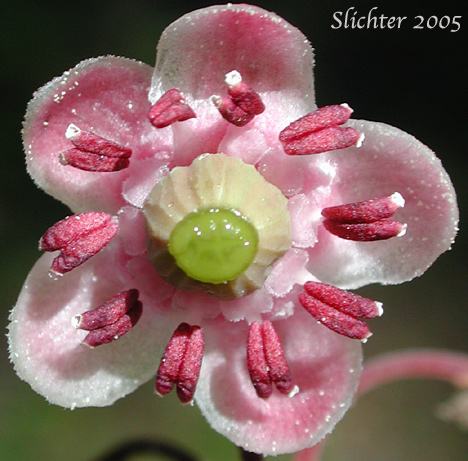
 The photo at right shows
a close-up of prince's pine as seen along South Prairie Road, Gifford Pinchot
NF........June 30, 1990.
The photo at right shows
a close-up of prince's pine as seen along South Prairie Road, Gifford Pinchot
NF........June 30, 1990.
Prince's pine is an attractive perennial wildflower with erect to spreading branches from 20-30 cm high. The stems are yellowish-green and often branched and the herbage is largely glabrous. The evergreen leaves appear whorled and are oblanceolate to narrowly ovate, narrowing gradually to a very short petiole. The upper surface of the blades is glabrous or shiny green while the margins are toothed (See photos above and at right.). The leaves measure 3-8 cm long and 0.5-2.5 cm wide.
The inflorescence is a 3-15 flowered corymb atop a long slender, terminal flower stem. The pedicels are as long or longer than the width of the corolla. The calyx is 5-lobed with toothed margins, the lobes distinct nearly to the base of the calyx. The corolla is 6-8 mm wide with spreading to reflexed, pink-tinged petals. The fruit capsules are 5-7 mm wide and 5-chambered. The previous year's flower stems, topped by the dried capsules may persist into the next bloom year (See photo below.).
Prince's pine is commonly found in open to moderately dark conifer woods at moderate elevations in the mountains.
Prince's pine may be found from Alaska south to southern California and east to the Rocky Mts. of Colorado and further east to the forests of the eastern United States. It is also found in Eurasia.
In the Columbia River Gorge, it may be found between the elevations of 300'-4800' from near Angels Rest east to South Prairie Road, Rainy Lake and Mt. Defiance.